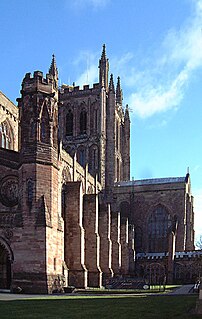Related Research Articles
Henry Wingham was a Lord Chancellor of England and Bishop of London.
John Chishull or John de Chishull was Lord Chancellor of England, Bishop of London, and Lord High Treasurer during the 13th century. He also served as Dean of St Paul's.
Henry of Newark was a medieval Archbishop of York.
Roger Niger was a thirteenth-century cleric who became Bishop of London. He is also known as Saint Roger of Beeleigh.
William Langton was a medieval English priest and nephew of Archbishop Walter de Gray. William was selected but never consecrated as Archbishop of York and Bishop of Carlisle.
William of Bitton was a medieval English Bishop of Bath and Wells.
William of Bitton was a medieval Bishop of Bath and Wells.
John Climping was a medieval Bishop of Chichester.

William of Louth, also known as William de Luda was a medieval Bishop of Ely.
Ralph Walpole was a medieval Bishop of Norwich and Bishop of Ely.

Richard Swinefield was a medieval Bishop of Hereford, England. He graduated doctor of divinity before holding a number of ecclesiastical offices, including that of Archdeacon of London. As a bishop, he dedicated considerable efforts to securing the canonisation of Thomas de Cantilupe, his predecessor, for whom he had worked during his lifetime. Active in his diocese, he devoted little time to politics. He was buried in Hereford Cathedral where a memorial to his memory still stands.
Henry of Lexington was a medieval Bishop of Lincoln.
Richard of Gravesend was a medieval Bishop of Lincoln.
Oliver Sutton was a medieval Bishop of Lincoln, in England.
Richard de Belmeis was a medieval cleric, administrator and politician. His career culminated in election as Bishop of London in 1152. He was one of the founders of Lilleshall Abbey in Shropshire.
William of Sainte-Mère-Église was a medieval Bishop of London.
Henry of Sandwich was a medieval Bishop of London.
Richard Gravesend was a medieval Bishop of London.
Richard Talbot was a medieval Bishop of London-elect.
Hamo was a 12th- and 13th-century English cleric. He was the Diocese of York's dean, treasurer, and precentor, as well as the archdeacon of the East Riding. His background is unknown, but he was probably a canon of the cathedral chapter at York Minster by 1171. He claimed to have been treasurer of the chapter by 1189, but did not actually hold the office until 1199. Hamo clashed with his archbishop, Geoffrey several times, and when Geoffrey died, Hamo's fellow canons were forbidden by King John of England from electing Hamo to succeed Geoffrey. Hamo died sometime after 1219, when he was last attested as holding his final office, dean.
References
- Greenway, Diana E. (1968). "Archdeacons: Colchester". Fasti Ecclesiae Anglicanae 1066-1300. Vol. 1, St. Paul's, London. Institute of Historical Research. Retrieved 29 October 2007.
- Greenway, Diana E. (1968). "Bishops". Fasti Ecclesiae Anglicanae 1066-1300. Vol. 1, St. Paul's, London. Institute of Historical Research. Retrieved 29 October 2007.